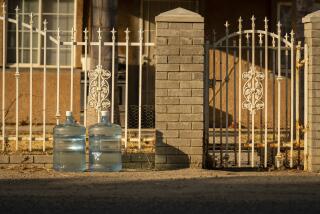O.C. Sees Cheap Water Era Ending
Orange County’s water picture is growing increasingly dire.
Although the amount has yet to be decided, officials announced last week that municipal water agencies must reduce the amount of water they draw from the aquifer that supplies the 2.2 million people who live in central and northern Orange County.
The impending cutbacks will leave cities from Anaheim to Irvine more dependent on water imported from Northern California and the Colorado River, sources that are increasingly drying up.
This triple-whammy of reduced supply comes at a time when the county’s population is booming, and some scientists believe Southern California is on the verge of a prolonged drought.
Conservation measures and increased storage capacity have kept county residents well-supplied with water so far. But if the drought and worst-case supply scenarios unfold, soaring water bills, parched brown lawns and dirty cars could become a reality as early as 2005.
“It’s not a crisis ... but it raises red flags,” said Ron Wildermuth, spokesman for Orange County Water District, which manages the aquifer. “We can’t keep continuing on this trend.”
Water agencies throughout Southern California are spending billions of dollars to ensure the region’s future water supply.
Still, “it’s all kind of coming home for everyone in Southern California that the times of cheap and plentiful water are rapidly ending,” said Dave Kiff, assistant city manager of Newport Beach.
The local aquifer, which provides 75% of the drinking water for northern and central Orange County, has been so over-tapped and under-replenished that it has sunk up to 30 feet below sea level in some parts of the county.
Local officials appear to be unanimous in the view that some reduction in the water drawn from beneath the ground will be required. The question, which won’t be answered until spring, is how much.
Under the worst-case scenario, cities would be forced to reduce their reliance on local ground water from 75% to 57%, making up the difference with higher-priced imported water, which could drive up water bills for the average household by as much as $30 a year by next year.
Rainfall in Santa Ana was just over 3 inches last winter--less than a quarter of average.
“Last year was really a pretty severe drought. We haven’t had big water for the last couple years,” said Glen MacDonald, an expert on climate with UCLA’s Institute of the Environment. “It’s very difficult to anticipate if this is a multiyear drought, and that’s the important thing.”
However, some scientists, including William Patzert, an oceanographer with NASA’s Jet Propulsion Laboratory in Pasadena, believe this is the beginning of a prolonged drought.
Patzert said a large-scale change in ocean temperatures appears to be shifting into a “cool phase” that could bring years--or even decades--of drought to the region.
“It’s getting serious,” Patzert said. “In Denver and Albuquerque, they’re rationing water. Of course, we’re not, because we steal water from everywhere else.”
Other states, including Nevada and Arizona, and the federal government, are beginning to resist California’s tendency to use more than its water allocation.
The state is under federal order to reduce the water it takes from the Colorado River. Meanwhile, decreased snowfall in the Sierra Nevada, pollutants that require dilution with purer water, and environmental concerns that can curtail the flow of river water mean there’s less to import from Northern California.
“The bottom line is that there’s a lot of people in Southern California,” Patzert said. “We haven’t rationed anybody in the last four years. We’re using it like drunken sailors.”
And the population will increase. Wildermuth said the state is projected to add 15 million people, nearly half of that in Southern California.
Orange County is expected to receive 300,000 to 700,000 people. Each will use about 140 gallons of water every day.
“While this is happening, the water industry is changing,” Wildermuth said. “It’s more difficult today to build an in-stream dam [or] canals [to carry more imported water]. The future is local and regional projects, conservation and water efficiency.”
To cope with these issues, the Metropolitan Water District of Southern California, OCWD and other agencies throughout the region are committing well over $2 billion to ensure the adequacy of future supplies.
“We can’t afford to take it for granted,” said Adan Ortega Jr., MWD’s vice president of external affairs.
One of the world’s most innovative water projects is being built in Orange County. The water district and the Orange County Sanitation District are working on a $600-million project to purify sewage and make it as clean as bottled water.
The first phase of the project is expected to be completed in 2007 and will create up to 72,000 acre-feet of water per year, or enough to supply nearly 600,000 people.
“It’s really tailor-made for drought--it’s locally controlled and it’s reliable, whether you have a drought or not,” Wildermuth said. “It diversifies the water portfolio.”
The agency is building catchment basins that will increase water percolating into the ground.
It is also installing pumps at the Santiago sand and gravel pits which can capture and hold as much as 4.6 billion gallons of Santa Ana River water to distribute to other percolation fields.
Water officials throughout the region are proposing to build seven desalination plants, which filter salt from seawater.
These projects would cost at least $1 billion, but MWD is offering subsidies to encourage their development.
Plants have been proposed in Dana Point and Huntington Beach, as well as in Los Angeles and San Diego counties. Ortega said desalinated water will eventually fill 10% of the local water demand.
MWD is also building a $1-billion pipeline through the San Bernardino Mountains that will bring more water to the Southland.
Another priority will be conservation. Although Southern Californians use less water than others in the United States, there is room for improvement.
One of the first targets could be over-watered lawns. Most yards are so drenched that if the excess were added up over a year, it could cover the entire lawn with five feet of water. In addition to straining water supplies, this also increases coastal pollution and often kills the plants residents are trying to tend.
Ortega of the MWD said if locals watered their yards more carefully this would reduce water consumption by 10%. Shorter showers, low-water-use toilets, showerheads and washers would also help.
Conservation is one of water officials’ constant refrains. The other is that residents must face increased water bills. “I’m worried, and I’m optimistic,” said Kiff of Newport Beach. “I’m worried about the cost because certainly the rates are likely to go up, and I’m optimistic that we can respond effectively by conserving.”
Pat Scanlon, the Southern California Water Co.’s district manager in Orange County, added, “Look at all of the utilities. Water’s the cheapest and people are used to that.... Those days are gone.”
More to Read
Sign up for Essential California
The most important California stories and recommendations in your inbox every morning.
You may occasionally receive promotional content from the Los Angeles Times.











